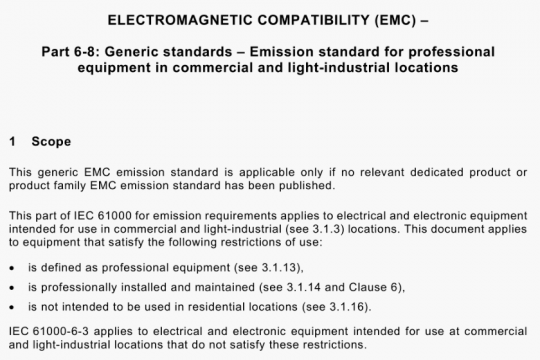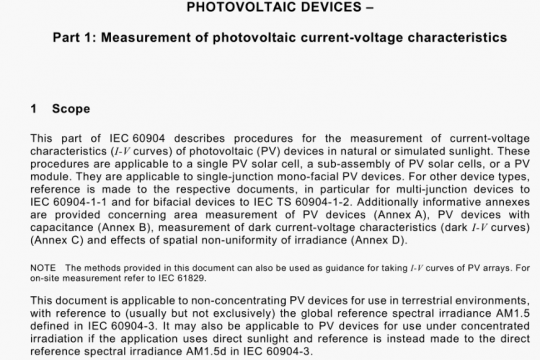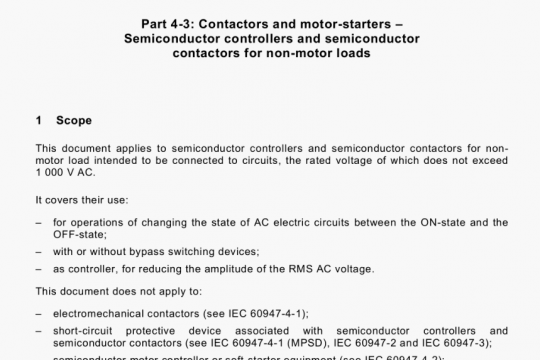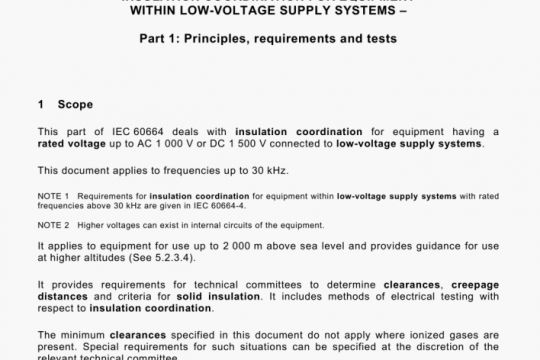IEC TR 63100-2017 pdf free
IEC TR 63100-2017 pdf free.Transmitting equipment for radiocommunication – Radio-over-fibre technologies for spectrum measurement – 100-GHz spectrum measurement equipment.
The following applications depend heavily on the development of mm-wave technology:
• IEEE 802.llad wireless devices;
• automotive radar;
• airport ground radar:
• mobile backhaul;
• uncompressed HD signal transmission.
4.2 IEEE 802.llad wireless devices
IEEE 802.1 lad wireless devices uses the 60-GHz band to implement multi-gigabit speeds. low latency, and secure connections between devices, Popular applications are replacement of display cables, and wireless connection between laptops. IEEE 802.llad wireless devices should be checked for bandwidth, 60-GHz in-band emissions, and out-of-band emissions up to 130 GHz. However, there is currently no commercial spectrum analyser with a pre-selector to remove unwanted internal frequency responses at bands over 100 GHz.
4.3 Automotive radar
Advanced driving assistant systems (ADAS) are being developed as a key technology for autonomous vehicles. ADAS uses various sensors, including radar, LIDAR and cameras. An ADAS radar detects small objects at high distance, velocity, and angle resolution using wideband FM CW modulation as the key technology. The world radio communication conference of November 2015 (WRC-15). agreed on the use of the contiguous 4-GHz band from 77 GHz to 81 GHz, and that demand for high-resolution mm-wave radar in the 79-GHz band will increase as ADAS becomes more widespread.
4.4 Airport ground radar
Following the Air France Concorde disaster in 2000. which was caused by engine ingress of runway debris, airport operators have been focusing on foreign object and debris (FOD) detection systems. Several technologies, such as cameras, lR, LIDAR, and other sensors are being tested. One candidate is the mm-wave radar because it can detect small metallic objects using converted automotive radar in the 77-GHz and 90-GHz bands. Both bands require a wider bandwidth for finer resolution and the 92-GHz to 100-GHz band could be used for industrial radio location.
4.5 Mobile backhaul
Mobile phones and terminals communicate by connecting to base stations that transfer data to the core network. Data from multiple base stations distributed throughout the communications area is transferred by a network of systems that collect and transfer data using various exchanges and wired and wireless technologies—this is called the mobile backhaul”, Wired technologies use optical fibres featuring larger traffic capacity than wireless and stable communications quality. However, optical fibre can sometimes suffer from installation problems due to difficult geography and high cost. On the other hand, wireless communications are easier and faster to Install and at a lower cost. Wireless also has advantages of easier service restoration after disasters. Wireless backhaul equipment is composed of an outdoor unit (ODU) and an indoor unit (IDL.J). The wireless signal is transmitted and received by antennas on the ODU. The IDU is connected to the network and handles sending/receiving of IF data to/from the ODU, as well as data transmission.
Most wireless backhaul frequency bands are below 38 GHz but some 60-GHz and 70-GHz to 80-GHz bands have been allocated to secure wider bandwidth for implementing larger- capacity and faster transfers. Since frequency bands and applications depend on national laws governing radio, not all bands are available in all regions.
4.6 Uncompressed HD signal transmission
Digital terrestrial television broadcasting is spreading rapidly, typically as high-definition television (HDTV) broadcasts. Transmitting raw HDTV broadcast materials is difficult because uncompressed HDTV signals have a data rate of 1.5 Gbit/s, requiring a wide bandwidth. Broadcasters normally use microwave radio to transmit broadcast materials, but the current transmission capacity is insufficient. Moving pictures experts group (MPEG) signal compression causes latency that adversely affects smooth conversation in live broadcasts. Consequently, TV broadcasters require high-capacity wireless link technology supporting transmission of uncompressed HD signals. Use of 120-GHz band wireless links with a centre frequency of 125 GHz and data transfer up to 10 Gbitls supports transmission of uncompressed HD signals. It was trialed at the 2008 Beijing Olympics.IEC TR 63100 pdf free download.




